OHS - PowerPoint PPT Presentation
1 / 13
Title:
OHS
Description:
... substances-pathogenic, carcinogenic or teratogenic substances or any highly ... Carcinogenic, teratogenic or highly toxic chemicals including. cytotoxic drugs ... – PowerPoint PPT presentation
Number of Views:144
Avg rating:3.0/5.0
Title: OHS
1
OHS W/Ethics and Safety Overview
2
Occupational Health, Safety and Welfare
- OHS W is everyones responsibility
- Students are responsible for
- not placing themselves or others at risk of
injury - reporting hazards associated with their class or
other activities to the relevant staff member - reporting every incident and injury irrespective
of its seriousness to the relevant staff member - http//www.unisa.edu.au/ohsw/procedures/studentinf
ormation.asp
3
Human Research Ethics
- Any research that involves contact with human
subjects requires ethics approval - This includes (but may not be limited to)
- Clinical research
- Action research projects
- Research involving data collection by interviews,
questionnaires, focus groups, observation - Use of human tissue
- In addition to personal contact, access to
medical records or access to other records that
are not publicly available and which identify
individuals, and which contain intimate personal
information also requires ethics approvals
4
Human Research Ethics
- http//www.unisa.edu.au/res/ethics/human.asp
5
Biohazards Clearance
- The use of hazardous substances-pathogenic,
carcinogenic or teratogenic substances or any
highly toxic chemicals that require special
precautions to be taken in their use or storage,
requires safety approval. - Researchers are required to consider what
biosafety/health and safety issues relate to
their research and must be aware of the
legislative and regulatory requirements which
apply to their research. The provisions must be
complied with.
6
Biohazards Clearance
- Applications for approval must be made for work
involving - Pathogenic substance in Risk Group 3 or 4
(AS/nzs2243.3) - Carcinogenic, teratogenic or highly toxic
chemicals including - cytotoxic drugs
- IARC Monographs Groups 12 Carcinogens
- heavy metals
- chemicals with a ChemWatch chronic or acute
health risk rating of 4 - Projects which propose the use of large amounts
of chemicals with a relatively low toxicity (risk
rating of 3 or below) should also be approved
before their commencement.
7
Biological Hazards
- Research involving the use of biological hazards
must be approved by the Institutional Biosafety
Committee - This includes pathogenic organisms of Risk Group
3 or 4 of the Australian Standards - Research involving GMOs (Genetically Modified
Organisms) must also be approved by the
Institutional Biosafety Committee
8
Chemical Hazards
- Research involving chemical hazards must be
approved by the Chemical Hazards Committee
9
Biohazards Clearance
- http//www.unisa.edu.au/res/ethics/biohaz.asp
10
Animal Experimentation
- All research involving animals must be approved
- It is necessary for all applications for approval
of the use of animals to be considered at a
meeting of the Institute of Medical and
Veterinary Science (IMVS) Animal Ethics Committee
(AEC), appointed by the Minister of Environment
and Conservation, the Minister responsible for
animal welfare.
11
Animal Experimentation
- http//www.unisa.edu.au/res/ethics/animal.asp
12
Plant, equipment devices and pressure vessels
- If your project involves the use of plant,
equipment, devices or pressure vessels that are
not part of the normal plant, equipment, devices
or pressure vessels assessed and managed by the
school or institute under its routine
Occupational Health Safety and Welfare (OHSW)
responsibilities, please complete a Project
Proposal Safety Authorisation form (OHSW70) (Word
doc) and submit it to your Head of
School/Institute Director.
13
Radiation Safety
- If you intend to use radiation and/or radioactive
material in your research or teaching, please
contact the Universitys Radiation Safety
Officer, Mr John Pattison (ext 23043 or email
john.pattison_at_unisa.edu.au). The Radiation Safety
Officer oversees radiation-related activities. - http//www.unisa.edu.au/ohsw/procedures/radpolicie
s.asp































